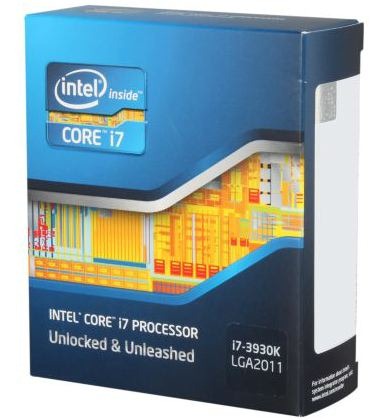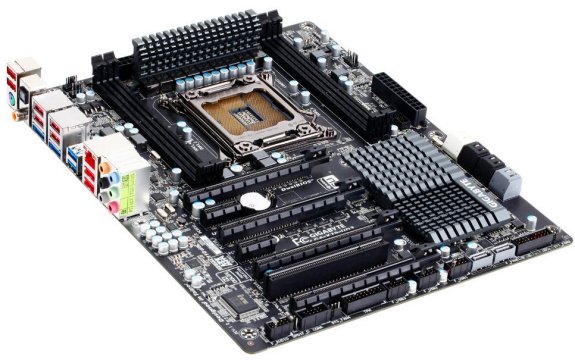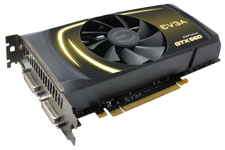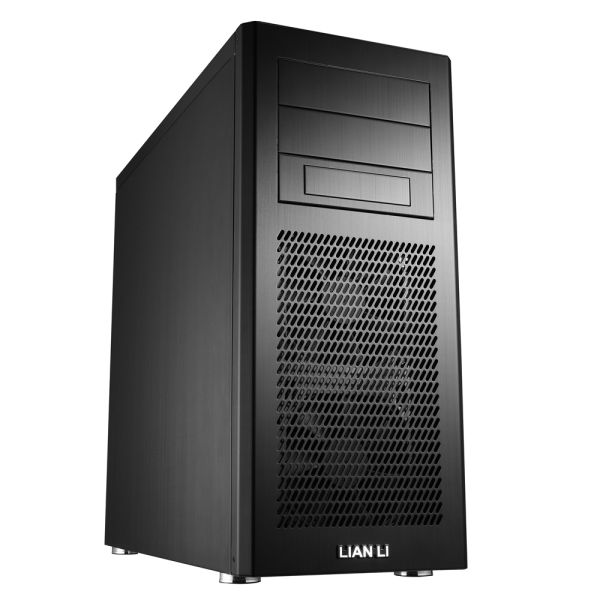Holiday 2011 Mainstream High-End Buyer's Guide
by Zach Throckmorton on December 9, 2011 12:00 AM EST- Posted in
- Guides
- AMD
- Intel
- Sandy Bridge
- CrossFire
- Sandy Bridge E
- Holiday 2011
- NVIDIA
Productivity powerhouse

Intel's Sandy Bridge-E CPU architecture recently launched in the form of two SKUs: the $1000 Core i7-3960X and the $600 Core i7-3930K. These chips differ ever so slightly in that the 3960X has 15MB L3 cache compared to the 3930K's 12MB L3 cache, and the 3960X's stock and Turbo clockspeeds are 100MHz higher than the 3930K's. That is, $400 clearly represents very diminishing returns. Anand reviewed the 3960X recently and found that compared to the Core i7-2600K, the 3960X won in single-threaded performance by a very narrow margin. By extrapolation, the 3930K recommended for this productivity PC will perform very similarly to the 2600K in single-threaded applications. However, because of the SNB-E chips' extra two cores compared to the 2600K, their multi-threaded performance advantage is, as Anand put it, "staggering."
You can see how the 3960X fares against the 2600K on Bench—and recognize that the 3930K we're recommending here will perform ever so slightly slower than the 3960X (unless you choose to overclock). It is critical to understand the nature of your workflow—are you using heavily multi-threaded applications or not? If you are, will your workflow performance improve enough using a 3930K over a 2600K to justify the extra $300 or so cost? If the answer to both of these questions is "yes", then this computer is designed for you. Because neither SNB-E CPU comes with a cooler, we're once again going with Corsair's H80 water-cooling kit.

Intel's SNB-E CPUs use a new socket, LGA 2011. Gigabyte's GA-X79-UD3 is an ATX form factor motherboard that represents a good value amongst X79 chipset boards. If your applications benefit from GPU acceleration, it has two PCIe x16 and two PCIe x8 lanes, though of course filling those lanes will push the cost of the build from just over $2000 to much higher depending on what GPUs you buy.
SNB-E supports quad channel memory, and the GA-X79-UD3 has four DIMM slots. The board's max memory support is 32GB, though we're going with 16GB total here for cost reasons. Again, springing for four 8GB modules might or might not be worth the additional investment; you'll have to make that decision based on your particular needs.
One of the drawbacks with SNB-E compared to SNB is that there's no integrated graphics at all, so you need to buy some form of GPU even if you don't plan on playing any games. Then again, for professional video work you'd almost certainly want a decent GPU regardless. Given we're looking at the high-end of the market and recommending a $1000  platform, we're going to give our primary recommendation to NVIDIA's GTX 560, which has slightly less CUDA cores and lower clocks than the GTX 560 Ti but still represents a fairly healthy upgrade from the GTX 550 Ti. We're going with NVIDIA here as we've had reasonably good experiences using their GPUs in Adobe Premiere, though you can just as easily go with an AMD Radeon HD 6850--and the two GPUs would trade blows in gaming benchmarks.
platform, we're going to give our primary recommendation to NVIDIA's GTX 560, which has slightly less CUDA cores and lower clocks than the GTX 560 Ti but still represents a fairly healthy upgrade from the GTX 550 Ti. We're going with NVIDIA here as we've had reasonably good experiences using their GPUs in Adobe Premiere, though you can just as easily go with an AMD Radeon HD 6850--and the two GPUs would trade blows in gaming benchmarks.
If you feel the GTX 560 is overkill for what you plan on doing, our alternate recommendation is AMD's Radeon HD 6670, which costs about half as much but only has one third the performance potential. Our NVIDIA alternative at the low end would be the GT 440 GDDR5, which costs a bit more than the HD 6670 but should also have a bit better performance. On the other hand, if you're really doing professional work, you'd probably want a workstation level OpenGL card. Never mind that most workstation users buy prebuilt systems--we've covered that market already. For a DIY workstation, you could easily double the cost of what we're putting together by adding a high-end Professional card. In that case, you probably know better than us whether you'd like a Quadro 5000/6000 or a FirePro V8800/V9800, so we'll leave the choice to you.
Because a $2000 PC without an SSD is a travesty, we're recommending Crucial's M4 128GB again, a reliable, relatively speedy SSD with lots of space for your OS and productivity applications with large installation sizes. Many workflows (such as intensive Photoshop usage) benefit from a fast scratch disk, so we're also including a Samsung F3 1TB. Finally, to round out the storage, we have a capacious 3TB Hitachi Deskstar for mass storage. At the risk of sounding repetitive, be  sure you understand your workflow before dropping hundreds of dollars on storage configurations you might not really need. As noted in the HTPC build, you might also want to hold off on the third storage drive until HDD prices drop.
sure you understand your workflow before dropping hundreds of dollars on storage configurations you might not really need. As noted in the HTPC build, you might also want to hold off on the third storage drive until HDD prices drop.
Though this PC is extremely powerful, it is not especially power-hungry. A productivity computer should be, above all else, reliable, and for this reason SeaSonic's SS-560KM power supply gets our recommendation. This is a highly efficient PSU and in my experience, it's very quiet and supplies components with very clean power. Work PCs are often conservative in their looks, but Lian-Li's PC9F looks very sharp while looking modest. It's also a great case in terms of its thermals and acoustics.
| Component | Product | Price |
| CPU | Intel Core i7-3930K | $600 |
| CPU cooler | Corsair H80 | $94 |
| Motherboard | Gigabyte GA-X79-UD3 ATX | $270 |
| RAM | (2) Crucial 8GB (2x4GB) DDR3 1333 | $80 (total) |
| GPU | EVGA GeForce GTX 560 | $180 ($15 MIR) |
| GPU (Alternate) | Sapphire Radeon HD 6670 | $80 ($15 MIR) |
| SSD | Crucial M4 128GB | $210 |
| HDD | Samsung Spinpoint F3 1TB | $150 |
| HDD | Hitachi Deskstar 3TB | $260 |
| PSU | SeaSonic SS-560KM 560W | $135 |
| Case | Lian-Li PC9F | $120 |
| Optical drive | ASUS DRW-24B1ST/BLK/B/AS | $19 |
| Operating system | Microsoft Windows 7 Professional | $130 |
| Total: | $2248 | |
We have a few concluding remarks on the next page.










52 Comments
View All Comments
methudman6 - Friday, December 9, 2011 - link
I really like the Work PC build. I was wondering though, any reason to choose the Crucial ssd over an Intel 320 series? I know that Crucial m4 is sata III, but do you believe Crucial to be as reliable as Intel?Z Throckmorton - Friday, December 9, 2011 - link
In the absence of hard data from controlled studies, it's difficult to asses which products of any type, including SSDs, are the most reliable. We have to rely on anecdotal evidence from forums, reviews on retail sites, and coverage from recognized authorities like Anand. And sadly the plural of anecdote isn't data! That said, my personal opinion is that I would be comfortable running both M4s and 320s, as well as Samsung 830s. I have an M4 in my netbook and a 320 in my daily driver desktop, and none of my clients have experienced issues with either of these drives. FWIW.Vikendios - Friday, December 9, 2011 - link
If you are going to spend hours immersing in Skyrim, the glory of what you see comes first. A 30 inch monitor running at 2650 x 1900 with full effects is such a quantum leap from anything else that I cannot imagine calling "high end" anything without,It is precisely like building an audiophile music systems. What makes the sound ? The speakers. That's where the money should go, and all the rest is just support electronics.
Running 2650 x 1900, a single 580 is quite unsufficient. My rig has a two-chip 590 because I'm lazy at setting up SLI's or triple card systems. Where you can save is memory : 6 G is ample for most games, and SSD's. A good old harddrive will work fine, you won't see the difference.
The second most important luxury is silence, so you can enjoy perfect audio. I toyed with liquid cooling, but ended up solving radically the problem by leaving the innards in a closet on the other side of the wall from my den. Only a small hole in the wall behind my desk to thread cables for the monitor, the keyboard and the mouse. The sound is hooked to the hifi system in my room. Added benefit : no case neede, all components just sit on a shelf.
Enjoy.
Zap - Friday, December 9, 2011 - link
The Lian Li PC-Q08 is to me a curious choice for an HTPC case. There are many great looking HTPC cases out there that fits in better with the typical home theater equipment. My home theater has a receiver, DVD player, CD player and cable company provided digital tuner that are all around the same width. A micro tower would look decidedly out of place in that mix. My own HTPC uses a Lian Li PC-C50B which is "officially" an HTPC case and is the same size as all the rest of the equipment. Other nice cases which I considered are the Silverstone Grandia series and even the Silverstone Milo. Those would all fit in with the other equipment. So, why the micro tower?mino - Saturday, December 10, 2011 - link
A good way to show your incompetence.yorkman - Monday, December 12, 2011 - link
I'm stuck with this dilemma...I'd like to build a system that Rybka Aquarium (chess engine) will really take advantage of. It eats up whatever cores you have so the more the better.The rig in this guide is something I'm considering...but I'm not sure how much I'd benefit over the 2600K setup, or especially 2500K when used with Rybka for 24x7 analysis. Going with the 3930K would be considerably more expensive. The cpu alone is about $350 more, plus the mobo is about $100 more than the mobo for the 2500/2600.
I've been using Rybka for years and I noticed the higher you clock your cpu the stronger it is, for obvious reasons. So overclocking will be a must. I haven't seen any benchmarks for an overclocked 3930X so it's hard to guess. I'd also be using 6 man tablebases would be where I'd need at least 16 GB of ram.
I'm told Rybka doesn't take advantage of hypter-threading so the 2500K seems to be more logical...but less cache and slightly slower clock than the 2600K. Plus I do the occasional video editting in Pinnacle Studio so 2600K might be better regardless.
How much would you recommend the 3930K in my situation? Or would I be better off still with the 2500 or 2600? Perhaps there's yet another cpu I've not mentioned? I know I could go Xeons but that's way over my budget I think.
vishnusivathej - Monday, December 12, 2011 - link
totol 24CPU cores,
24Gigs of RAM
ASUS KGPE-D16 SSI EEB 3.61 Server Motherboard Dual Socket G34 AMD SR5690 DDR3 800/1066/1333
Item #: N82E16813131643
Return Policy: Standard Return Policy
Protect Your Investment (expand for options)
$429.99
Crucial 8GB (2 x 4GB) 240-Pin DDR3 SDRAM DDR3 1333 (PC3 10600) ECC Registered Server Memory Model CT2KIT51272BB1339
Item #: N82E16820148354
Return Policy: Memory Standard Return Policy
$299.97
($99.99 each)
Corsair Force Series GT CSSD-F120GBGT-BK 2.5" 120GB SATA III Internal Solid State Drive (SSD)
Item #: N82E16820233191
Return Policy: Limited Replacement Only Return Policy
Protect Your Investment (expand for options)
-$60.00 Instant
$30.00 Mail-in Rebate Card
$249.99
$189.99
AMD Opteron 6234 Interlagos 2.4GHz Socket G34 115W 12-Core Server Processor OS6234WKTCGGUWOF
Item #: N82E16819113030
Return Policy: CPU Replacement Only Return Policy
Protect Your Investment (expand for options)
$779.98
($389.99 each)
Subtotal: $1,699.93
yorkman - Monday, December 12, 2011 - link
I assume this was directed at me?Problem with that is, yes, I'd get 24 cores for an extra $1100 or so...but this is the deal breaker in my opinion...it's 2.4GHz*2=4.8GHz...something I could achieve with one 2600K cpu alone when overclocked.
The server cpu's usually can't be overclocked...so that means I'm getting 20 extra cores which is awesome, and roughly the same speed as a 2600K would get me. But it'd use up more power per month and $1100 more...plus I can't even find these parts locally which means I'd have to order them from who knows where...then add shipping on top of that and hope that no parts come in as dead on arrival.
Not sure that's a better pc. Where did you look up the prices for this? I'm in Canada so I'd prefer to order from here and not go through the border (duty fees are extra and would cost an arm and a leg extra on top of the $1100). Definitely not worth it then.
yorkman - Monday, December 12, 2011 - link
Ok, I see those quotes are from newegg.com...but since I'm in Toronto, they are not available to me (cpu). The mobo is at newegg.ca, but it's deactivated anyway.Checked on eBay....only available to customers in the U.S. so I don't think this is even an option for me.
It's got me curious on how much stronger Rybka 4 would run though given the extra 18-20 cores...but same clock speed.
Without the ssd drive, and if this can be purchased from Canadian customers somewhere....it's $1500+tax which would work out to about $1700 all in minus shipping. I'm not considering duty fees because I wouldn't pay them so I wouldn't order them from outside Canada.
And wouldn't this mobo be a better deal Supermicro H8DGU Server Motherboard - AMD - Socket G34 LGA-1944. It's about $100 cheaper when compared to the Asus in CDN dollars.
yorkman - Monday, December 12, 2011 - link
One more thing. This one would probably benefit me more:AMD Opteron 6234 2.60 GHz Processor - Socket G34 LGA-1944
as apparently Rybka 4 doesn't take advantage of HT, and can even slow it down...so with this dual cpu combo I'd gain 400 MHz (not much I know) and save about $100.
Either way, nobody in Canada seems to have this in stock for sale...nor can it be ordered. I wonder why.